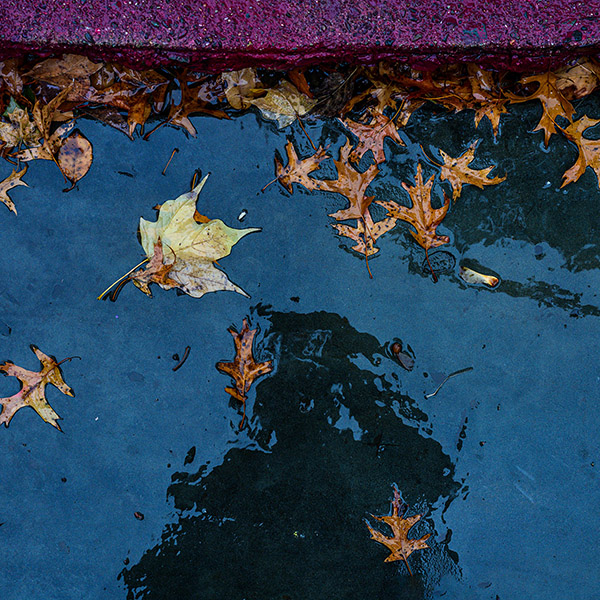I had spent my career photographing the beauty of autumn in its prime, the brilliant colors of leaves still on the trees and filling the countryside with a colorful palette of warm autumn tints. Thoreau taught me to drill down deeper, not to stop at the surface gloss. He found significant meaning for life infused in the even the tiniest and seemingly insignificant elements of nature that abounded around him.
This year's session was photographed with a Nikon Z7 and 24-70mm f/2.8 S lens. All the photos were taken on a sidewalk of time-worm slate slabs during a heavy rain that left everything wet, and sometimes submerged, with the water reflecting the blue color of the sky in contrast to the bright, warm colors of the autumn leaves. Below are a small outtake from over my final selection of 54 images that make up this year's portfolio.
Here is the passage from Autumnal Tints, written by Henry David Thoreau in 1862. He was expounding on the difference between looking and seeing when he also wrote: "Objects are concealed from our view, not so much because they are out of the course of our visual ray as because we do not bring our minds and eyes to bear on them....
"It is pleasant to walk over the beds of these fresh, crisp, and rustling leaves. How beautifully they go to their graves! how gently lay themselves down and turn to mould!--painted of a thousand hues, and fit to make the beds of us living. So they troop to their last resting place, light and frisky. They put on no weeds, but merrily they go scampering over the earth, selecting the spot, choosing a lot, ordering no iron fence, whispering all through the woods about it,--some choosing the spot where the bodies of men are mouldering beneath, and meeting them half-way. How many flutterings before they rest quietly in their graves! They that soared so loftily, how contentedly they return to dust again, and are laid low, resigned to lie and decay at the foot of the tree, and afford nourishment to new generations of their kind, as well as to flutter on high! They teach us how to die. One wonders if the time will ever come when men, with their boasted faith in immortality, will lie down as gracefully and as ripe,--with such an Indian-summer serenity will shed their bodies, as they do their hair and nails."
Thoreau took the time to look closely at the most ordinary objects in his path. His examination always found meaning beyond the thing itself. Photography should be like that.


















